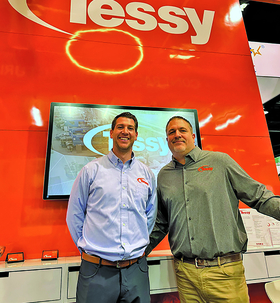Complex molding tasks give Tessy a chance to shine

Andrew Schunk
Anaheim, Calif. — Contract manufacturing is the name of the game for customers — typically OEs in the medical space — that are looking to design and produce medical components.
In fact, design for manufacturing, or DFM, often is the only game in town, according to Eric Yando, director of sales for Tessy Plastics Corp., a custom contract manufacturer based in Skaneateles, N.Y.
“We play in all spaces and look at every opportunity on an individual basis,” Yando told Rubber News, a sister publication of Plastics News, Feb. 6 at the IME West Show, which drew more than 14,000 people over three days to the Anaheim Convention Center. “With these individual cases, Tessy has evolved over the past five or six years from a standard injection molder to a company that focuses on downstream, value-added processes.”
“If there is a piece of automation attached to the process or complex molding, any value-added process … we play in the high-tech, complex spaces for medical components,” Yando said.
Founded in 1973, Tessy celebrated its golden anniversary last year.
The company works in the medical, pharmaceutical, diagnostics and consumer health care markets, in that order of market percentage and typically in liquid silicone rubber, thermoplastic elastomers and thermoplastic urethanes.
“With the two-shot applications is where we work in rubber, over molding a base component with a TPE or TPU seal,” Yando said. “LSR has seen really good growth over the past five years, and for us this all started in the research and development lab.”
LSR can be “a little different than standard injection molding,” Yando said.
“Now we are a large-scale, high-cavitation molder for a lot of our customers in this space.”
With research and design manufacturing facilities — measuring about 3.2 million square feet in total — in New York, Pennsylvania and Shanghai, China, the company has net sales of about $500 million annually.
The company made two key acquisitions in 2019 (now Tessy Automation and Tessy Tooling), complementary business units that vertically integrate the Skaneateles (pronounced “skinny atlas”) firm.
Tessy Automation and Tessy Tooling are both based in Pennsylvania — Meadville and Erie, respectively.
Ultimately, outsourced or in-house partnerships are a function of the part’s requirements.
For instance, Tessy Tooling — a fourth arm for development and production is Tessy Shanghai — may not be best suited to making a consumer health care mold.
“With some LSR molds, perhaps we need to leverage our own company or others, as needed,” Yando said. “But the support of those systems in-house is a net benefit for us. From a capabilities perspective, bringing these companies under the Tessy umbrella has really helped.”
Inside the iterations
There are a dizzying amount of choices to be made in the medical component development world, and getting a company like Tessy on board sooner rather than later can reduce cost and improve time to market.
Rob Benson, a research and development engineer who has been with Tessy for five years, works on a variety of project designs and has experience in a range of materials and manufacturing processes.
“The customer may have a material selected, like polyisoprene, and they want to do a conversion,” Benson said. “We will look at the LSR on the market, or perhaps there is a secondary operation in the fabrication phase where there could be some cost savings with polyisoprene.”
While an LSR transitions from a cold deck to cure in a hot mold, a TPE moves from a hot environment to a cool mold to cure.
Typically, injection molding machines that process LSR are exclusive from those that process TPEs, though some can be retrofitted for either material.
In total, Tessy is “approaching” 10 LSR lines for injection molding.
No matter what material ultimately is selected for a project, onboarding a contract manufacturer early in the process is critical, Yando said.
“How we set our business up, we are heavy on the engineering side,” he said. “We put a dedicated team of resources on the front end of any project, and Rob is part of that team.”
On the front end, Benson analyzes the baseline testing metrics of a new material or component against an existing material or component; conducts material characterization tests; and pushes the process into product design phases, whether that might include injection molding or micro molding.
“This is critical for time-to-market,” Benson said. “Learnings up front can be transferred to tooling and production. How are we going to transfer the part, pick the part?
“All of these learnings enable cost efficiency and help us push the product to market more quickly,” he added.
Simulation can play an important role in the front end of product development, as well.
“We leverage tools to analyze the risk of the production of any component,” Yando said. “Then we see if this is proved true, and we figure out how to overcome the issues.
“We use a ‘fail fast’ philosophy. … We want to close that loop to continue the upfront development process,” he added.
While a new medical part might be Tessy’s development passion for a time — sometimes years — ultimately the contract manufacturer does have to “let it go.”
“As a contract manufacturer, we do not own the ultimate design,” Yando said. “As part of our services, we hand those designs to our customers. … The design ultimately is owned by them.”
The horizon looks bright for Tessy, even as it navigates a shifting industry landscape, post-COVID-19.
